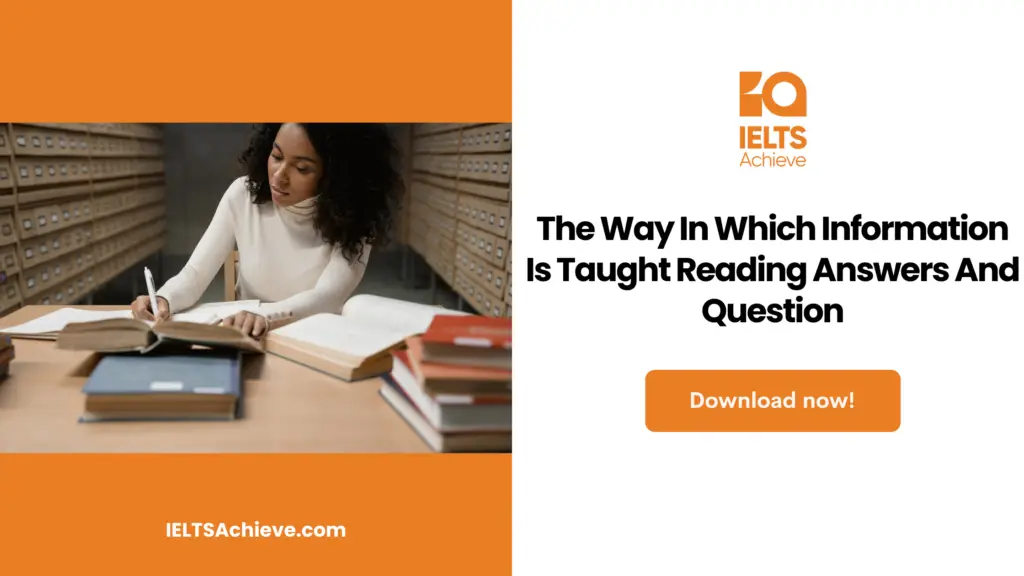The Blog post contains the following IELTS Reading Questions:
- IELTS Reading Multiple CHoice Questions
- IELTS Reading Matching Features
- IELTS Reading True/False/Not Given
Stay informed and prepared for success – Explore our comprehensive Reading Test Info page to get valuable insights, exam format details, and expert tips for mastering the IELTS Reading section.
IELTS Reading Passage -The Way In Which Information Is Taught

The Way In Which Information Is Taught
The way in which information is taught can vary greatly across cultures and time periods. Entering a British primary school classroom from the early 1900s, for example, one gains a sense of austerity, discipline, and a rigid way of teaching. Desks are typically seated apart from one another, with straight-backed wooden chairs that face directly to the teacher and the chalkboard. In the present day, British classrooms look very different. Desks are often grouped so that students face each other rather than the teacher, and a large floor area is typically set aside for the class to come together for group discussion and learning.
Traditionally, it was felt that teachers should be in firm control of the learning process and that the teacher’s task was to prepare and present material for students to understand. Within this approach, the relationship students have with their teachers is not considered important, nor is the relationship students have with each other in the classroom. A student’s participation in class is likely to be minimal, aside from asking questions directed at the teacher, or responding to questions that the teacher has directed at the student. This style encourages students to develop respect for positions of power as a source of control and discipline. It is frequently described as the “formal authority” model of teaching.
A less rigid form of teacher-centred education is the “demonstrator” model. This maintains the formal authority model’s notion of the teacher as a “flashlight” who illuminates the material for his or her class to learn, but emphasis a more individualized approach to form. The demonstrator acts as both a role model and a guide, demonstrating skills and processes and then helping students develop and apply these independently. Instructors who are drawn to the demonstrator style are generally confident that their own way of performing a task represents a good base model, but they are sensitive to different learning styles and expect to provide students with help on an individual basis.
Many education researchers argue for student-centered learning instead and suggest that the learning process is more successful when students are in control. Within the student-centered paradigm, the “delegator” style is popular. The delegator teacher maintains general authority, but they delegate much of the responsibility for learning to the class as a way for students to become independent thinkers who take pride in their own work. Students are often encouraged to work on their own or in groups, and if the delegator style is implemented successfully, they will build not only a working knowledge of course-specific topics but also self-discipline and the ability to coordinate group work and interpersonal roles.
Another style that emphasizes student-centered education is the “facilitator” mode of learning. Here, while a set of specific curriculum demands is already in place, students are encouraged to take the initiative for creating ways to meet these learning requirements together. The teacher typically designs activities that encourage active learning, group collaboration, and problem-solving, and students are encouraged to process and apply the course content in creative and original ways. Whereas the delegator style emphasizes content and the responsibility students can have for generating and directing their own knowledge base, the facilitator style emphasizes form and the fluid and diverse possibilities that are available in the process of learning.
Until the 1960s, formal authority was common in almost all Western schools and universities. As a professor would enter a university lecture theatre, a student would be expected to rush up, take his bag to the desk, and pull out the chair for the professor to sit down on. This style has become outmoded over time. Now at university, students and professors typically have more relaxed, collegiate relationships, address each other on a first-name basis, and acknowledge that students have much to contribute in class. Teacher-centered education has a lingering appeal in the form of the demonstrator style, however, which remains useful in subjects where skills must be demonstrated to an external standard and the learning process remains fixed in the earlier years of education. A student of mathematics, sewing or metalwork will likely be familiar with the demonstrator style. At the highest levels of education, however, the demonstrator approach must be abandoned in all fields as students are required to produce innovative work that makes unique contributions to knowledge. Thesis and doctoral students lead their own research in facilitation with supervisors.
The delegator style is valuable when the course is likely to lead students to careers that require group projects. Often, someone who has a high level of expertise in a particular field does not make for the best employee because they have not learned to apply their abilities in a coordinated manner. The delegator style confronts this problem by recognizing that interpersonal communication is not just a means of learning but an important skillset in itself. The facilitator model is probably the most creative and is, therefore, not suited to subjects where the practical component necessitates a careful and highly disciplined manner, such as training to be a medical practitioner. It may, however, suit more experimental and theoretical fields ranging from English, music, and the social sciences to science and medical research that takes place in research labs. In these areas, “mistakes” in the form are important and valuable aspects of the learning and development process.
Overall, a clear evolution has taken place in the West from a rigid, dogmatic, and teacher-dominated way of learning to a flexible, creative, and student-centered approach. Nevertheless, different subjects, ages, and skill levels suit different styles of teaching, and it is unlikely that there will ever be one recommended approach for everyone.
The Way In Which Information Is Taught Reading Questions
Questions 1 – 8
Look at the following statements (Questions 1 – 8) and the styles of teaching below. Match each statement with the correct teaching style, A – D, in boxes 1 – 8 on your answer sheet. NB You may use any letter more than once.
- The emphasis is on students directing the learning process.
- The teacher shows the class how to do something, then students try it on their own.
- Student-teacher interaction and student-student interaction is limited.
- The emphasis is on the process of solving problems together.
- Students are expected to adjust to the teacher’s way of presenting information.
- The teacher designs group activities that encourage constructive interaction.
- Time is set aside for one-on-one instruction between teacher and student.
- Group and individual work is encouraged independently of the teacher.
List of teaching styles
A Formal authority
B Demonstrator
C Delegator
D Facilitator
Improve your performance in Matching Features questions by clicking here to access our comprehensive guide. Learn how to match specific features or characteristics with the options provided in the IELTS Reading section.
Questions 9 – 12
Do the following statements agree with the information given in Reading Passage 1? In boxes 9 – 12 on your answer sheet, write
TRUE if the statement agrees with the information
FALSE if the statement contradicts or disagrees with the information
NOT GIVEN if there is no information on this
9. The formal authority model remains popular in educational institutions of the West ___________________
10. The demonstrator model is never used at the tertiary level . ________________
11. Graduates of delegator style teaching are good communicators. _______________
12. The facilitator style is not appropriate in the field of medicine. _________________
Enhance your skills in identifying information as True, False, or Not Given. Click here to discover expert strategies and techniques for mastering this question type in the IELTS Reading section.
Question 13
Choose the correct letter. A, B, C or D and write it on your answer sheet.
13. What is the best title for Reading Passage 1?
- Teaching styles and their application
- Teaching: then and now
- When students become teachers.
- Why student-centred learning is the best
Ready to improve your performance in Multiple Choice Questions (MCQs)? Click here to access our comprehensive guide on how to tackle MCQs effectively in the IELTS Reading section.
Unlock your full potential in the IELTS Reading section – Visit our IELTS Reading Practice Question Answer page now!
Recommended Questions:
Renewable Energy IELTS Reading Question with Answer
The Way In Which Information Is Taught Reading Answers
1. Answer: C
2. Answer: B
3. Answer: A
4. Answer: D
5. Answer: A
6. Answer: D
7. Answer: B
8. Answer: C
9. Answer: FALSE
10. Answer: NOT GIVEN
11. Answer: TRUE
12. Answer: FALSE
13. Answer: A

We hope you found this post useful in helping you to study for the IELTS Test. If you have any questions please let us know in the comments below or on the Facebook page.
The best way to keep up to date with posts like this is to like us on Facebook, then follow us on Instagram and Pinterest. If you need help preparing for the IELTS Test, join the IELTS Achieve Academy and see how we can assist you to achieve your desired band score. We offer an essay correction service, mock exams and online courses.
